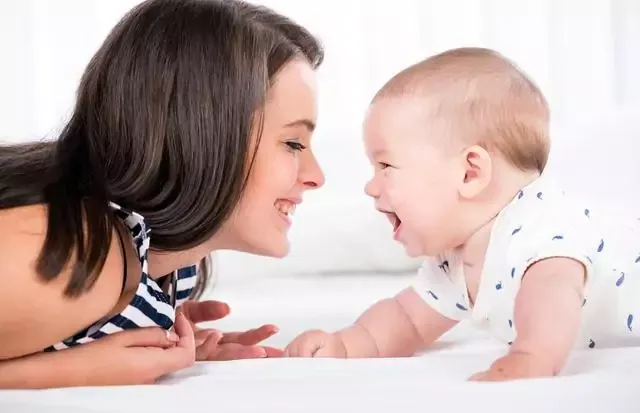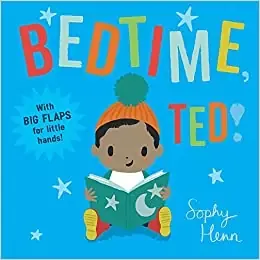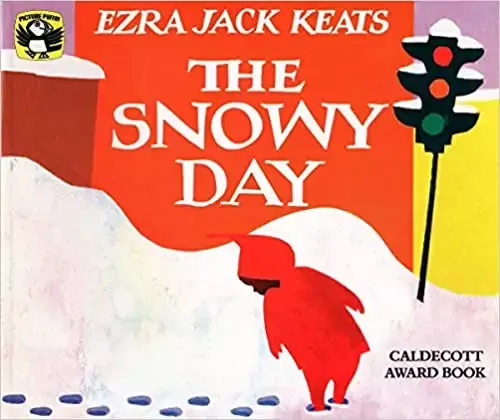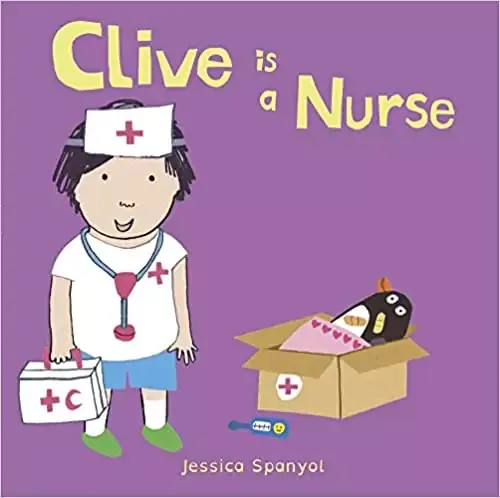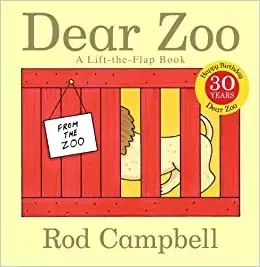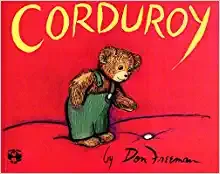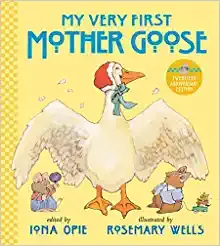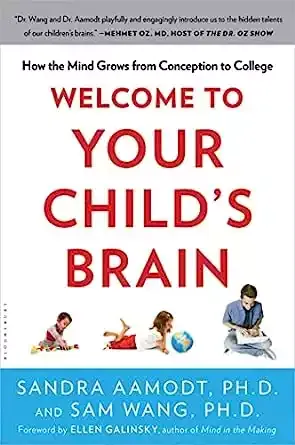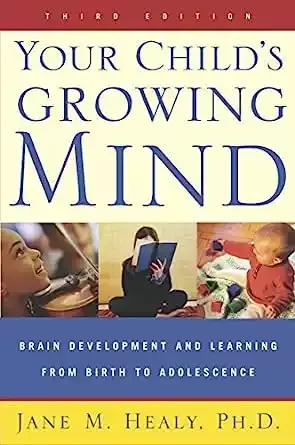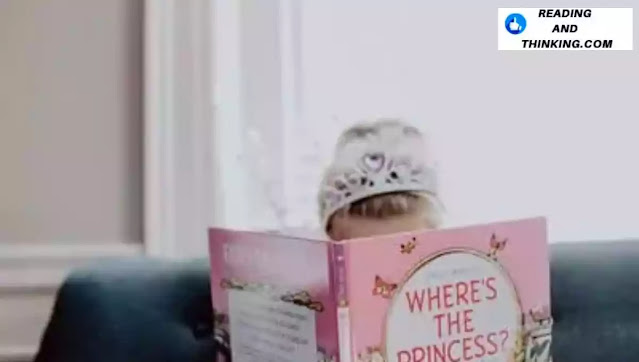The below-recommended books and the development of children's brains at different ages. It applies to parents following early learning – How to Support Healthy Brain Growth like How to Build Your Baby's Brain, Boosting Brain Development, Boost Baby Brain by Reading, and Boost Mental Development of Babies.
In fact, if your kids are from 1 to 12 months old, or 1, 2, or 3 years old to 7 years old, you can follow this article.
The development of the brain determines the future development of a child, but for the infant stage, we still do not know the level of the child's IQ.
But if you want to know whether your baby's innate brain development is excellent, you can judge based on some of the baby's life characteristics.
For example, what some parents call "the child recognizes the birth", or crying after leaving home, and so on.
I will share with you The 20 Best Books For Baby Brain Development to read in 2024.
1. Bedtime, Ted! by Sophy Henn
Ted is a sweet but willful toddler. In Bedtime, Ted! His parent tells him it’s time for bed, but Ted’s not ready yet! First, he has to take a bath, have a snack, brush his teeth, and get all the wiggles out.
In this book, each spread has a gatefold with big flaps perfect for little hands. When the gatefold is closed, Ted tells his parent that he can’t go to bed just yet because he has something to do first. When the gatefold opens, readers can see what that something really is. The second book in the series, Let’s Go, Ted! will be released in Fall 2018.
2. The Snowy Day by Ezra Jack Keats
This book is a must-read book almost every day in the winter when my son is about three years old.
The little boy in the book looks very much like him.
On a snowy day, make snowmen, play with snowballs, leave deep and shallow footprints on the snow, shake off the snow from the trees, and climb up and slide down on the snowdrift...
When you see the little boy bring When the returning snowball melts and disappears, you will be sad and sad.
When I saw the melted snow in my dreams unfold before my eyes, I was also very excited.
I hope that all these experiences will become good memories for him in the future.
Through this book, you can also better feel the beauty and wonder brought by the changes of the seasons.
3. Clive is a Nurse by Jessica Spanyol
What will Clive be like today? Follow Clive and his friends as they explore the many things a nurse does in a day.
Role-play is crucial to a child's positive development, boosting language and social skills, and building self-confidence.
This humorous and caring interaction of an inclusive group of playmates will inspire young readers to create their own diverse roles, free of gender stereotypes.
4. Dear Zoo by Rod Campbell
Dear Zoo is twenty-five years old - and still as popular as ever! And with an updated look, this children's classic is sure to delight a new generation of readers!
"Macmillan World Classic Game Book: Dear Zoo" Brief introduction: The child wants to keep a pet, and the enthusiastic zoo sends all kinds of animals, such as unruly camels, scary lions, scary snakes, naughty monkeys... …What animal will he choose as his pet in the end?
With lifelike animals, easy-to-understand text, and humorous and interesting content, opening the book is like being in a lovely animal kingdom.
5. Leo Can Swim by Anna McQuinn
Leo, Lola’s little brother from Leo Loves Baby Time, is back on a new adventure at the pool.
Leo loves the water! Leo and Daddy go to swimming class where they kick, bounce, splash around, and dive like little fish. Joining other babies and their caretakers in the pool is a guarantee of unforgettable fun.
This sweet story full of action and sound effects is a gentle introduction to pool facilities and parent-child swim lessons with a cast of diverse families who love to splash and play together.
6. Is Your Mama a Llama? by Deborah Guarino
Lloyd the llama is looking for his mama. "Is your mama a llama?" he asks a bat, a swan, a cow, a seal, a kangaroo.
Young children will share Lloyd's delight when the answer to his question is finally, " Yes!" With rhyme and riddle, this charming story has become a favorite.
7. Jesse Bear, What Will You Wear? by Nancy White Carlstrom
Jesse Bear, what will you wear? What will you wear in the morning! My shirt of red was Pulled over my head in the morning. And so Jesse Bear starts his day.
It isn't really an unusual day for a little bear, but the weather is warm and sunny and just right for all the things Jesse Bear enjoys doing - like playing in his sandbox, chasing butterflies, and swinging in his swing.
At the end of the day, a tired Jesse Bear is ready for bed, and for wearing Sleep in my eyes stars in the skies Moon on my bed, And dreams in my head...
Lilting verse and exuberant paintings combine to make Jesse Bear's day a very special one indeed, in a book that even the youngest readers will want to return to again and again.
8. Corduroy by Don Freeman
Corduroy is a bear who once lived in the toy department of a big store. Day after day he waited with all the other animals and dolls for somebody to come along and take him home.
The store was always filled with shoppers buying all sorts of things, but no one ever seemed to want a small bear in green overalls. Kuduro the bear used to live on the toy counter of a large department store. Like other animals and dolls, he was expecting someone every day...
9. My Very First Mother Goose by Iona Opie
To a small child, words are magical. And the most magical of all are the beloved, venerable words of Mother Goose. Now folklorist Iona Opie has gathered more than sixty treasured rhymes in their most perfect, honest form.
From "Hey Diddle, Diddle "and "Pat-a-Cake" to "Little Jack Horner" and "Pussycat, Pussycat," these are familiar verses that have been passed from parent to child for generations; these are the rhymes that are every child's birthright.
With watercolors by Rosemary Wells that may prove equally enduring, MY VERY FIRST MOTHER GOOSE captures the simple joy and the sly humor that are the essence of Mother Goose.
Parents and children will find themselves exploring this volume together, savoring delightful details and funny surprises on every page. This is a book that promises hours of quiet smiles and merry grins for readers of all ages.
10. Gossie: A Gosling on the Go! by Olivier Dunrea
Meet Gossie, a small yellow gosling who loves to wear bright red boots—every day. One morning Gossie can’t find her beloved boots.
She looks everywhere for them: under the bed, over the wall, even in the barn. Preschoolers will enjoy helping Gossie find her red boots and delight in where Gossie finally finds them.
Do you have a book about child brain development that has impacted the way you think or serve children in libraries?
11. How to Build Your Baby's Brain by Gail Gross
The truth is, that nature and nurture are in a delicate dance--if one goes too fast, the other one falls. Science tells us that early childhood experiences have the capacity to structure and alter the brain.
That means you didn't just supply your child's DNA--you're still shaping it. And it's only by wielding this power that your child will activate their full potential.
You are truly a gene therapist; manipulating and guiding your child's genetic makeup based on the experiences you create for them.
Contrary to what modern parenting trends have told us, parenting is much simpler than we dared to imagine.
Great parenting comes down to one mission: to be prepped and present for the windows of your child's development so that you can take full advantage of them and help your child become a smart, successful, self-sufficient adult.
It doesn't require formal training or a fancy degree--all it takes is getting involved. Once parents learn how to flip the right gene "switches," they can expand the limits of their child's potential and lay the emotional and intellectual groundwork that allows them to seize opportunities for success fearlessly, naturally, and enthusiastically.
With a Ph.D., Ed.D., and M.Ed., in education and a second in psychology, as well as over forty-seven years of experience as an educator, Dr. Gross combines an understanding of childhood development with practical and realistic tools to teach parents how to best take advantage of their child's developmental windows.
How to Build Your Baby's Brain translates the results from scientific studies about expanding consciousness and performance into day-to-day interaction between parents and children.
12. Welcome to Your Child's Brain by Sandra Aamodt & Sam Wang
The author of this book is Sandra Amot and co-authored by Wang Shenghong. The two authors have worked in the field of neuroscience for more than 40 years.
Among them, Amott is the editor of the top journal "Nature Neuroscience" in the field of neuroscience and a popular science writer, and Wang Shenghong is a professor at Princeton University in the United States. and a researcher.
This book is rich in content and is an encyclopedic work. In the book, two top brain scientists explain to parents how a child's brain develops and grows from the perspective of parenting, covering the entire process of brain development from the mother's pregnancy to the child's college entrance.
By reading this book, you can understand what affects children's language ability, academic performance, and character development.
Most importantly, this book is like a clear road map for brain development.
It will lead you to avoid the trap of wrong brain common sense and provide timely and effective help when children have problems with brain development.
Whether your child has just been born or is already a teenager, you can quickly find the answer you want in the book.
13. Brain Rules for Baby by John Medina
The author of this book is a masterpiece of family education written by the famous American neuroscientist John Medina.
The whole book clarifies how the brains of fetuses and infants work from a scientific point of view, and summarizes dozens of brain rules to help parents all over the world raise children who are smart, healthy, happy, happy, and productive during the golden growth stage before the age of 5. nurturing baby.
This is a very interesting book, and it has helped many pregnant mothers dispel a lot of rumors. Maybe we think it is useful during pregnancy. This book clarifies that it is just a rumor from a scientific point of view.
In this book, Dr. John Medina has fully bridged the gap between parent education practice and scientific research results.
It can not only solve the urgent needs of parents in the process of raising children but also tell you the secret weapon to obtain family happiness.
No matter whether you are planning to conceive a baby or you are a new parent, this book can provide you with all-around and all-around information on parenting, and it will become a necessary guidebook at your bedside.
14. The Whole Brained Child by Daniel J. J. Siegel & Tina Payne Bryson
This book mainly talks about: the parenting style of parents determines the way of thinking of children.
When parents were still enrolling their children in English classes and Mathematical Olympiad classes, the concept of developmental education "The Whole Brained Child" has become popular in the United States and has changed the parenting methods of thousands of parents.
The authors of the book are Daniel J. Siegel and Tina Payne Bryson.
Siegel is a well-known positive psychologist in the United States, a doctor of medicine from Harvard University, and a clinical professor of psychiatry at the University of California, Los Angeles. Continues to produce groundbreaking work in the fields of the brain, psychotherapy, and parenting.
Among them, the most famous ones are "The Seventh Sense", "Parenting from the Inside Out" and "Whole Brain Parenting".
His works have been published in "New York Times", "Los Angeles Times", "Newsweek" and "Time" many times, and he is active in NBC, ABC, and other well-known media.
Bryson is a child and adolescent psychotherapist, well-known parenting expert, and director of the Seventh Sense Institute, dedicated to children's education and development.
The two authors studied the structure of the brain and the functional development that the brain is responsible for. Different brain structures are responsible for different functions. They applied these findings to daily parenting practice.
Let parents transform their children's various emotional outbursts, disputes with partners, or unknown fears into opportunities to integrate their children's brains and cultivate "whole-brain children".
The "The Whole Brained Child" mentioned in the book can help parents raise more peaceful and happy children.
15. The Yes Brain by Daniel J. Siegel & Tina Payne Bryson
"The Yes Brain: How to Cultivate Courage, Curiosity, and Resilience in Your Child" is another masterpiece of Siegel and Bryson.
The book introduces the use of scientific methods to teach parents how to help their children achieve true inner success.
The four directions of balance, resilience, insight, and empathy, it guide children to acquire an open brain and understand their inner nature. And ways to help kids develop the four traits, teaching them important life skills.
- Balance is the ability to manage emotions and behaviors so that children will not lose their minds.
- Resilience is the ability to bounce back when life's inevitable problems and challenges arise.
- Insight Ability to examine and understand oneself, make informed decisions based on one's own insights, and better control one's own life.
- Empathy is the ability to understand another's point of view, care about others, and take action when appropriate to improve a situation.
The book introduces various methods. Parents can help their children become emotionally stable and express themselves actively;
16. Brainstorm by Daniel J. Siegel MD
The book tells us: adolescence is both a confusing and incredible period of life, which lasts from about 12 to 24 years old. Across cultures, adolescence is seen as a huge challenge, both for the adolescent child and for the adults who help and support them.
Children in adolescence have four essential characteristics: they seek novelty, actively participate in society, have strong emotions, and continue to explore creatively.
Significant changes in the way they think and behave compared to childhood reveal underlying problems. What parents have to do is understand these characteristics, minimize the disadvantages, and maximize the advantages.
To solve all the challenges of adolescence, help parents communicate more benignly with their children. Dr. Siegel applies the "whole-brain parenting method" to adolescence, starting from the "seventh sense", providing a large number of methods to help parents integrate the left and right brains, transform the insecure attachment mode into a secure attachment mode, and create a Calm, tolerant growth environment.
The author of this book has undergone three large-scale revisions, and now this book contains scientific research results, stories, and practical skill exercises—tools for the seventh sense, which can promote brain development and help life progress.
17. Bright from the Start by Jill Stamm
Bright from the Start: The Simple, Science-Backed Way to Nurture Your Child's Developing Mind from Birth to Age 3
"How to Scientifically Develop Your Child's Brain: A Guide to IQ and EQ Development"
A guide to pioneering parenting for ages 0-3
American infant brain development expert Jill Stam’s 30-year practice summary—brain science knowledge that parents should understand: attention, parent-child bonding, and communication skills are three simple and effective key parenting elements, helping parents easily develop high IQ, High EQ children.
18. What's Going on in There? by Lise Eliot
What's Going on in There? : How the Brain and Mind Develop in the First Five Years of Life
Discover the potential of children's brains and seize the critical period of parenting!
How much of a child's brain development is genetically determined? How much is determined by the environment?
How can parents better develop their children's brains to help them become smarter and happier?
Combining the latest research results of brain science and the experience of being a mother, the author of this book answers the concerns of these parents regarding the development rules of sensory, and motor skills, social interaction, emotion, language, memory, intelligence, and other functions.
She believes that innate heredity and acquired experience together make each of us unique; every decision made by parents during the critical period from conception to the child's 5-year-old will affect the development of the child's brain.
In this book, she also shows parents many practical concepts and methods that help children's intellectual development.
- What is the developmental path of the baby's senses, motor skills, memory, language, etc.?
- Which prenatal factors have the greatest impact on your baby's brain development?
- When is the critical period for a baby's sensory, language, and emotional development?
- How do boys' and girls' brains develop differently?
19. Brain Stages by Patricia Wilkinson & Jacqueline Frischknecht
Brain Stages: How to Raise Smart, Confident Kids and Have Fun Doing It, K-5
Brain Stages is the ultimate leg up for parents and caregivers in today’s complicated, competitive world.
A grade-by-grade guide through the formative elementary school years, this book will show you how to have fun with your kids as you help them grow into successful, well-adjusted humans.
Drawing from thousands of hours of research and decades of education experience, veteran teacher Patricia Wilkinson and learning expert Jacqueline Frischknecht, Ph., offer tools and advice that will boost your child’s brainpower, social skills, and love for learning.
In Brain Stages, you’ll discover:
- How brains develop and what you can do to help your child succeed
- The best form of praise that builds confidence and self-esteem
- Surefire ways to help a struggling child get caught up in math or reading
- How to get your gifted child’s needs met
- Ideas for helping an anxious child relax for better learning
- Tips for teaching kids the art of building healthy relationships
- Over 150 fun games and activities to engage and nurture young minds
Whether you have a child who has fallen behind, an extra smart kid you want to keep intrigued, or a grade-schooler who could use some help getting along with others, Brain Stages will give you the information and support you need to be an effective parent and enjoy your child-raising journey.
20. Your Child's Growing Mind by Jane Healy
Your Child's Growing Mind: Brain Development and Learning From Birth to Adolescence.
The classic guide to understanding children’s mental development is now updated and better than ever!
Hailed by parents and educators, Your Child’s Growing Mind is a window into the fascinating process of brain development and learning. It looks at the roots of emotion, intelligence, and creativity, translating the most current scientific research into practical suggestions for parents and teachers.
Dr. Healy also addresses academic learning, offering countless suggestions for how parents can help without pushing. She explains the building blocks of reading, writing, spelling, and mathematics and shows how to help youngsters of all ages develop motivation, attention, critical thinking, and problem-solving skills.
Using the science of childhood development, she also examines today’s hot issues, including learning disabilities, ADHD, influences of electronic media, and the hazards of forced early learning. From infancy to adolescence, this is the perfect guide to helping and enjoying a youngster’s mental, personal, and academic growth.

